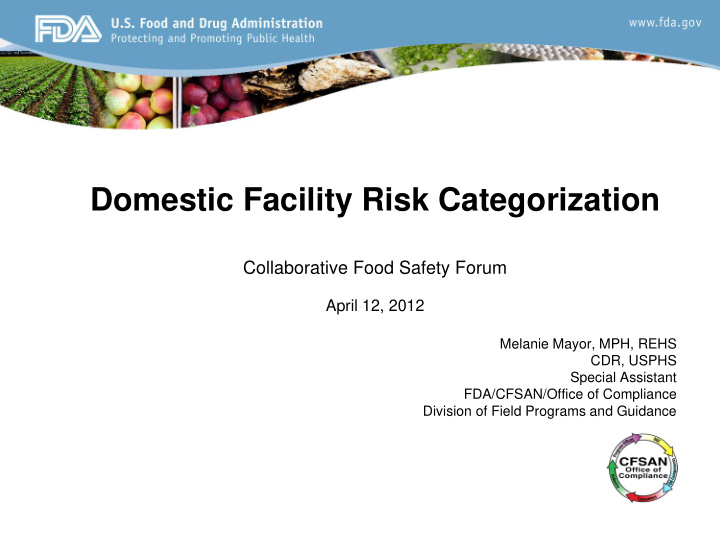



Domestic Facility Risk Categorization Collaborative Food Safety Forum April 12, 2012 Melanie Mayor, MPH, REHS CDR, USPHS Special Assistant FDA/CFSAN/Office of Compliance Division of Field Programs and Guidance
Categorization Factors • Identifying high-risk facilities based on factors established by regulation: – Known safety risks of the food, – Compliance history of a facility, – Facility’s hazard analysis and risk -based preventive controls, – Certifications for imported foods (VQIP), – Any other criteria deemed necessary. 2
Categorization Factors • Known safety risks of the food – Identified food commodity categories associated to food recalls and foodborne outbreaks. • Compliance history of a facility – Facilities with a history of non-compliance with food safety regulations, those with violations of regulatory significance. 3
FSMA Domestic Facility Risk Categorization Facility manufactures food commodity category associated with outbreaks AND class I recalls within previous 5 Identify known Ye fiscal years. safety risks of s Food • Food commodity OR category associated High-Risk 2 Ye Ye with Outbreaks, s s Required to register Class I Recalls Facility manufactures under Sec. 415 food commodity category Requirements (BT) 1 associated with outbreaks OR class I recalls and NOT inspected within 5-years. N o N N o Section o 421(a) requirements do not apply. Compliance History Inspection classifications Non-High-Risk 3 within previous five N years. o • Violative inspections, History of non- compliance. 1. Fiscal years based on data from agency’s Official Establishment Inventory (OEI). Resources have been allocated for facili ties not required to register under Sec. 415 but should be inspected. 2. Inspect within three-year period. 3. Inspect within seven-year period.
Current Status • Approach is to inspect high-risk facilities at least once in the first 3-years rather than the first 5- years. • Food facility inventory based on agency’s Official Establishment Inventory. 5
Current Status • FDA may inspect facilities more often than the frequency mandate as a result of emerging public health information or follow-up to regulatory actions. • Identifying high-risk and non-high-risk facilities will be an iterative process. 6
Challenges • Limitations on data – Product level, processing, distribution, multiple food commodities. – Inventory is dynamic and subject to change. • Communicating internally messages of enhanced surveillance program. 7
Challenges • Competing resources with operational activities for other FDA-regulated products. • Reporting and tracking requirements for Annual Report. 8
Next Steps • Determine how to implement deliverables from other FSMA Workgroups. • Consider other factors and criteria to determine facility risk categorization. • Continue to enhance a data-driven decision- making process. • Communicate and outreach to stakeholders. 9
10
Acknowledgements FSMA Frequency of Inspections Workgroup • ORA – Division of Planning, Evaluation, and Management – Office of Regional Operations – Risk Management • CFSAN – Division of Field Programs and Guidance – Outbreak Team – Recalls Team And many more.... 11
Thank You! Welcome comments! melanie.mayor@fda.hhs.gov 12
Recommend
More recommend